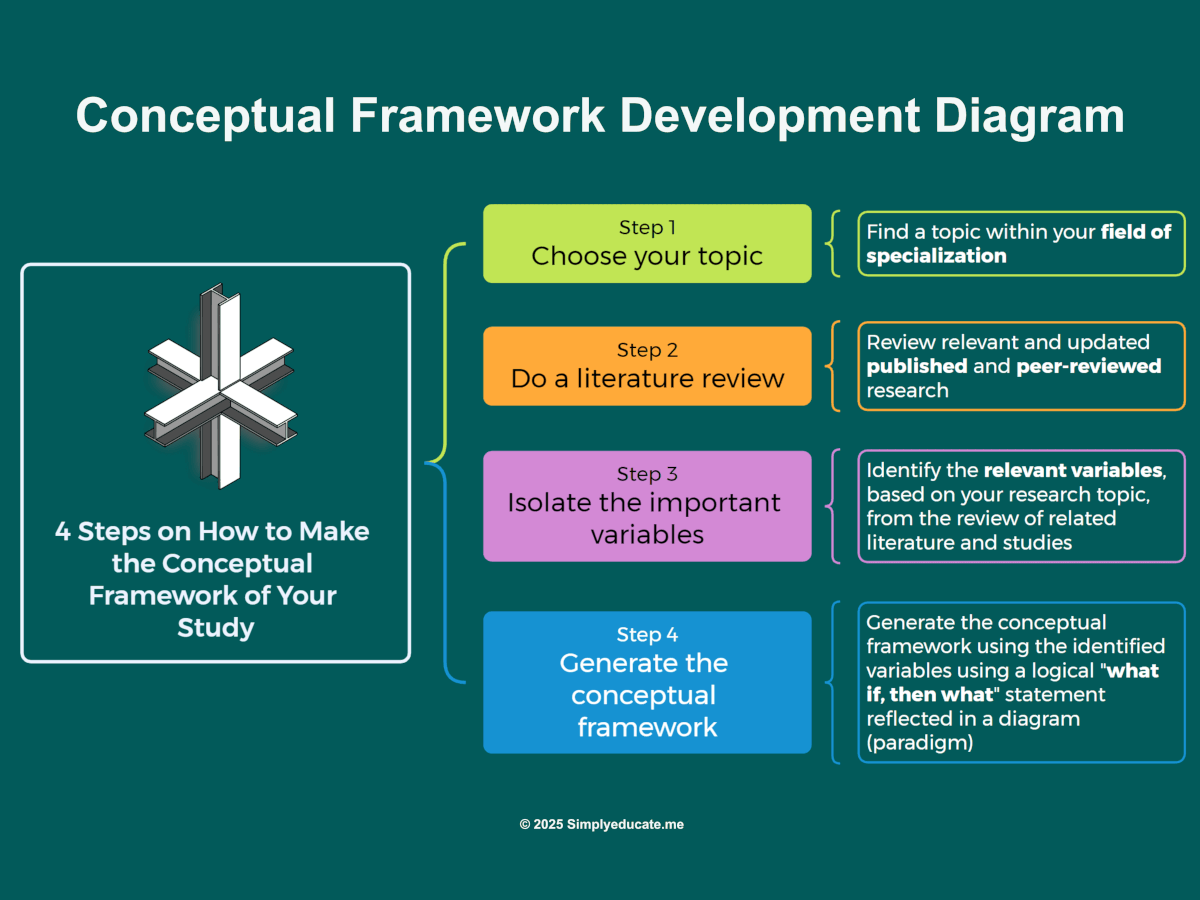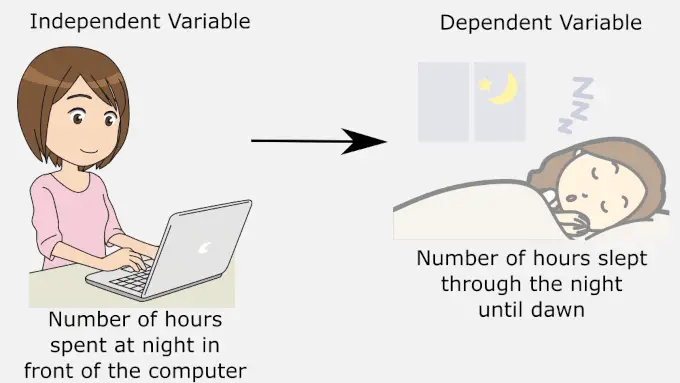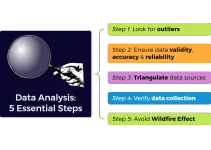What is a conceptual framework? How do you prepare one? This article defines the conceptual framework and lists the steps on how to prepare it. A simplified example is added to strengthen the reader’s understanding.
In preparing your research paper as one requirement for your course as an undergraduate or graduate student, you will need to write the conceptual framework of your study. The conceptual framework steers the whole research activity. The conceptual framework serves as a “map” or “rudder” that will guide you towards realizing your study’s objectives or intent.
What, then, is a conceptual framework in empirical research? The next section defines and explains the term.
Table of Contents
Definition of Conceptual Framework
A conceptual framework represents the researcher’s synthesis of the literature on how to explain a phenomenon. It maps out the actions required in the study’s course, given the researcher’s previous knowledge of other researchers’ point of view and his or her observations about the phenomenon studied.
The conceptual framework is the researcher’s understanding of how the particular variables in the study connect. Thus, it identifies the variables required in the research investigation. It is the researcher’s “map” in pursuing the investigation.
As McGaghie et al. (2001) put it: The conceptual framework “sets the stage” to present the particular research question that drives the investigation being reported based on the problem statement. The problem statement of a thesis gives the context and the issues that caused the researcher to conduct the study.
The conceptual framework lies within a much broader framework called a theoretical framework. The latter draws support from time-tested theories that embody many researchers’ findings on why and how a particular phenomenon occurs.
I expounded on this definition, including its purpose, in my recent post titled “What is a Conceptual Framework? Expounded Definition and Five Purposes.”
4 Steps on How to Make the Conceptual Framework

Before you prepare your conceptual framework, you need to do the following things:
Step 1: Choose your topic
Decide on what will be your research topic. The topic should be within your field of specialization. (Generate your research topic using brainstorming tips).
Choosing a research topic is one of the most critical steps in conducting any scholarly work because it defines the scope, direction, and relevance of your study. Your topic should fall within your field of specialization so that you can build upon your existing knowledge, skills, and expertise. Working within your discipline ensures that you understand the fundamental concepts, theories, and methodologies needed to examine the subject effectively.
When your research topic aligns with your specialization, you are more likely to:
- Identify meaningful knowledge gaps in existing literature because you are familiar with current trends and debates in your field.
- Apply appropriate methods confidently, since you have already been trained in tools and approaches used in your discipline.
- Gain credibility with your peers, mentors, and potential publishers, as your work will be recognized as grounded in your professional expertise.
Sustain interest and motivation, since the topic aligns with your academic and career goals.
Ultimately, selecting a topic within your specialization not only strengthens the quality of your research but also contributes more directly to the advancement of knowledge in your chosen area.
Step 2: Do a literature review
Review relevant and updated research on the theme that you decide to work on after scrutiny of the issue at hand. Preferably use peer-reviewed, and well-known scientific journals as these are reliable sources of information.
Prefer peer-reviewed and reputable journals in your literature review because they offer the best chance of reliable methods, extremely thorough or accurate results, and useful citations you can build on. A good literature review will show where the gaps, contradictions, and opportunities lie, and it will shape your research questions and methods.
Why peer-reviewed and up-to-date sources?
- Peer review increases the likelihood the methods and conclusions were critically evaluated.
- Recent studies show the current state of knowledge, methods, and debates.
- High-quality journals (and systematic reviews) help you identify accepted standards, commonly used instruments, and typical sample sizes.
- Using strong sources strengthens your credibility and the defensibility of your study.
Practical steps to do this effectively
- Define the scope and keywords. Convert your topic into 4–8 search terms (include synonyms and related concepts). Example: (“coastal erosion” OR “shoreline retreat”) AND (“community adaptation” OR “household resilience”).
- Search major databases. Start with discipline-specific and multidisciplinary databases: e.g., Web of Science, Scopus, PubMed (health), ERIC (education), IEEE Xplore (engineering), and Google Scholar for breadth. Your university library resources and indexes matter a lot. So, your library is still not obsolete. Visit them. You can browse both the digital and card catalog if they still exist. In the US, these are now replaced by modern online public access catalogs (OPACs) for over two decades.
- Prioritize recent and high-quality sources. Filter by date (last 3-5 years for most fast-moving fields), look for review articles and meta-analyses first to get the big picture. A review article synthesizes existing research to summarize a topic, while a meta-analysis is a statistical method within a systematic review that pools data from multiple studies to produce a single, more precise estimate of an effect. That saves you time for other more important process in developing your research proposal.
- Use well-known journals and citation metrics thoughtfully. Journal reputation helps, but always read the paper — a small, well-designed study in a newer journal can still be valuable. Using your judgment as to the relevance of a research article will be worthwhile. This approach particularly works in situations where your proposed study belongs to a relatively new field.
- Read critically, not passively. For each important paper note the research question, sample and context, methods, main findings, limitations, and how it relates to your topic. Keep a short annotated bibliography. Being keen is the mark of a true researcher.
- Look for methodological patterns and gaps. Ask: which methods are used most? What populations or contexts are under-studied? Are there conflicting findings? A rubric which can help you decide can help (see Table 1).
- Track citations forward and backward. Use cited-by tools in databases to find newer papers that cite a key article (forward citation). Check the reference lists of good papers (backward citation). A lot of citations of a paper indicates that the research is foundational or a solid reading to help advance knowledge on the particular subject matter.
- Manage references. Use a reference manager (Zotero, Mendeley, EndNote) to save articles, PDFs, and notes — it saves huge time later.
- Assess quality and bias. Check sample size, controls, statistical methods, conflicts of interest, and whether conclusions overreach the data. Many researchers tend to conclude more than their study has covered. In doing your own research, avoid being too general in your conclusions. Always stick to your findings.
- Synthesize, don’t summarize. Organize the literature into themes (e.g., theories, methods, findings, gaps) and write a narrative that leads naturally to your research question and justification. You can use a mind map to guide you on this activity.
- Cite responsibly and ethically. Give credit always, and be transparent about uncertainties and limits in the literature.
Table 1. Rubric for Evaluating Literature Review Findings
| Criteria | Excellent (4) | Good (3) | Fair (2) | Poor (1) |
|---|---|---|---|---|
| Identification of Common Methods | Clearly identifies multiple methods used in the majority of studies; explains why these methods are common and their strengths/limitations. | Identifies main methods used; provides some explanation of their relevance. | Mentions some methods but without clear linkage to their frequency or purpose. | Methods used are unclear, incomplete, or inaccurate. |
| Recognition of Under-studied Populations/Contexts | Accurately identifies specific populations or contexts with limited research; supports with evidence from reviewed studies. | Identifies some under-studied areas with minimal evidence or examples. | Mentions under-studied areas vaguely without clear evidence. | No mention or incorrect identification of under-studied areas. |
| Analysis of Conflicting Findings | Clearly describes areas where findings disagree; compares studies and discusses possible reasons for conflicts. | Notes some conflicting findings but with limited comparison or explanation. | Briefly mentions conflicts without analysis or context. | No identification or misunderstanding of conflicting findings. |
Scoring Guide
- 10–12 points = Excellent synthesis and critical thinking
- 7–9 points = Good understanding with some gaps
- 4–6 points = Limited analysis; mostly descriptive
- 1–3 points = Minimal or inaccurate evaluation
Step 3: Isolate the important variables
Identify the specific variables described in the literature and figure out how these are related. Some research abstracts contain the variables, and the salient findings thus may serve the purpose. If these are not available, find the research paper’s summary.
If the variables are not explicit in summary, get back to the methodology or the results and discussion section and quickly identify the study variables and the significant findings. Read the TSPU Technique to skim articles efficiently and get to the essential points with little fuss.
When identifying variables, it is important to distinguish between independent variables (factors the researcher manipulates or categorizes to observe their effect), dependent variables (the outcomes measured), and control variables (factors kept constant to reduce bias). Some studies also include moderating or mediating variables, which help explain or influence the relationship between the independent and dependent variables. Mapping these out — even in a simple diagram — helps clarify the research logic and the cause–effect pathways tested in prior studies.
Once the variables are clear, pay attention to the relationships reported.
- Are they positive, negative, or non-significant?
- Are they consistent across different studies or do results vary depending on context, sample, or methodology?
This process not only sharpens your understanding of how concepts interact in the existing literature but also reveals potential research gaps — such as variables that have been studied separately but not yet linked, or relationships tested only in limited populations or settings. These insights can guide the refinement of your own research framework.
Step 4: Generate the conceptual framework
Build your conceptual framework using your mix of the variables from the scientific articles you have read. Your problem statement or research objective serves as a reference for constructing it. In effect, your study will attempt to answer the question that other researchers have not explained yet. Your research should address a knowledge gap.
When constructing your conceptual framework, start by mapping out the relationships among the variables you have identified from the literature. This can be done visually (e.g., boxes and arrows showing causal links, correlations, or interactions) or narratively (explaining the logical connections in words). The framework should clearly indicate how the independent, dependent, and, if applicable, mediating or moderating variables are expected to relate to one another. Use evidence from prior studies to justify each link, but also highlight areas where evidence is weak or inconsistent — these are where your study can make its strongest contribution.
Your problem statement or research objective acts as the anchor for the framework, ensuring that every variable and relationship you include serves the central purpose of your study. Avoid adding variables just because they appear frequently in the literature; include only those that are directly relevant to answering your research question. Remember, the conceptual framework is not just a diagram — it is your study’s roadmap. It should demonstrate how your research builds upon existing knowledge while targeting a specific gap, making your work both original and necessary.
Example of a Conceptual Framework
Research Topic
Statement number 5 introduced in an earlier post titled How to Write a Thesis Statement will serve as the basis of the illustrated conceptual framework in the following examples.
The youth, particularly students who need to devote a lot of time using their mobile phones to access their course modules, laptops, or desktops, are most affected. Also, they spend time interacting with their mobile phones as they communicate with their friends on social media channels like Facebook, Messenger, and the like.
When free from schoolwork, many students spend their time viewing films on Netflix, YouTube, or similar sites. These activities can affect their sleeping patterns and cause health problems in the long run because light-emitting diode (LED) exposure reduces the number of hours spent sleeping.
Thesis Statement
Related to the students’ activity, we can write the thesis statement thus:
Thesis statement: Chronic exposure to blue light from LED screens (of computer monitors, mobile phones, tablets, and television) deplete melatonin levels, thus reducing the number of sleeping hours among the youth, particularly students who need to work on their academic requirements.
Review of Literature
The literature review supports the thesis statement as among those that catch one’s attention is a paper that warns against the use of LED devices at night. Although we can save a lot of electrical energy by using the efficient LED where the inventors Isamu Akasaki, Hiroshi Amano and Shuji Nakamura received a Nobel prize in physics in 2014, there is growing evidence that it can cause human health problems, particularly cancer.
Haim & Zubidat (2015) of the Israeli Center for Interdisciplinary Research in Chronobiology synthesized the literature about LEDs. They found out that blue light from the light-emitting diodes (LED) inhibits melatonin production, particularly during active secretion at night. Melatonin is a neuro-hormone that regulates sleep and wake cycles. Also, it can slow down aging and prevent cancer (Srinivasan et al., 2011).
Thus, looking directly at your laptop, mobile phone, or television at night not only can severely damage your eyes but also prevent the achievement of sound sleeping patterns. As a countermeasure, sleep experts recommend limiting the use of digital devices until 8 o’clock in the evening.
Those affected experience insomnia (see 10 Creative Ways on How to Get Rid of Insomnia); they sleep less than required (usually less than six hours), and this happens when they spend too much time working on their laptops doing some machine learning stuff, monitoring conversations or posts on social media sites using their mobile phones, or viewing the television at night.
Meanwhile, a related study on reducing bluelight from smartphone screen at night improved the sleep quality of students. Hence, this strengthens the previous findings that exposure to blue light from smart phone screens indeed need to be reduced if not eliminated to get a restful sleep.
Variables Isolated from the Literature
Using the background information backed by evidence in the literature review, we can now develop the study’s paradigm on the effect of LED exposure to sleep. We will not include all the variables mentioned and select or isolate only those factors that we are interested in.
Figure 1 presents a visual representation, the paradigm, of what we want to correlate in this study. It shows measurable variables that can produce data we can analyze using a statistical test such as either the parametric test Pearson’s Product-Moment Correlation or the nonparametric test Spearman Rho (please refresh if you cannot see the figure).

Notice that the variables of the study are explicit in the paradigm presented in Figure 1. In the illustration, the two variables are:
1) the number of hours devoted in front of the computer, and
2) the number of hours slept through the night until dawn.
The former is the independent variable, while the latter is the dependent variable. Both variables are easy to measure. It is just counting the number of hours spent in front of the computer and the number of hours slept through the night in the study subjects.
Assuming that other things are constant during the study’s performance, it will be possible to relate these two variables and confirm that, indeed, blue light emanated from computer screens can affect one’s sleeping patterns. (Please read the article titled “Do you know that the computer can disturb your sleeping patterns?” to find out more about this phenomenon). A correlation analysis will show if the relationship is significant.
Related Reading:
- How the conceptual framework guides marketing research
Evolution of a Social Theory as Basis of Conceptual Framework Development
Related to the development of the conceptual framework, I wrote a comprehensive article on how a social theory develops by incisively looking at current events that the world is facing now — the COVID-19 pandemic. It shows how society responds to a threat to its very survival.
Specifically, this article focuses on the COVID-19 vaccine, how it develops and gets integrated into the complex fabric of human society. It shows how the development of the vaccine is only part of the story. A major consideration in its development resides in the supporters of the vaccine’s development, the government, and the recipients’ trust, thus the final acceptance of the vaccine.
Social theory serves as the backdrop or theoretical framework of the more focused or variable level conceptual framework. Hence, the paradigm that I develop at the end of that article can serve as a lens to examine how the three players of vaccine development interact more closely at the variable level. It shows the dynamics of power and social structure and how it unfolds in response to a pandemic that affects everyone.
Check out the article titled “Pfizer COVID-19 Vaccine: More Than 90% Effective Against the Coronavirus.” This article shall enrich your knowledge of how an abstract concept narrows down into blocks of researchable topics.
References
Haim, A., & Zubidat, A. E. (2015). LED light between Nobel Prize and cancer risk factor. Chronobiology International, 32(5), 725-727.
McGaghie, W. C.; Bordage, G.; and J. A. Shea (2001). Problem Statement, Conceptual Framework, and Research Question. Retrieved on January 5, 2015 from http://goo.gl/qLIUFg
Randjelović, P., Stojanović, N., Ilić, I., & Vučković, D. (2023). The effect of reducing blue light from smartphone screen on subjective quality of sleep among students. Chronobiology international, 40(3), 335-342.
Srinivasan, V., R Pandi-Perumal, S., Brzezinski, A., P Bhatnagar, K., & P Cardinali, D. (2011). Melatonin, immune function and cancer. Recent patents on endocrine, metabolic & immune drug discovery, 5(2), 109-123.
©2015 January 5 P. A. Regoniel Updated: 10 August 2025
Cite as: Regoniel, P. A. (2015, January 5). Conceptual framework: a step-by-step guide on how to make one. Research-based Articles. https://simplyeducate.me/conceptual-framework-guide/




hallo! I would like to study “the socio-economic and environmental Impact of urban forests on livelihood: The perception of urban residents” how can my conceptual framework be like?
Hello Jesse, there are many free alternatives online if you are diligent enough in finding them. The reason I wrote this article is that in 2015, when I originally wrote it, I could not find an easy-to-understand explanation of the conceptual framework which will help my students. I also have a vague knowledge of the concept at that time, even with the available literature. Hence, I painstakingly gathered all materials I could from online and offline literature, synthesized them, and wrote about the concept in the simplest way I could without losing the essence. Now, I have seen many articles and even videos using the ideas I have rigorously prepared. If you find the tedious work I did irrelevant, then perhaps the ebook is expensive notwithstanding the many expenses on hosting, domain name, time and effort in maintaining the site that I incur in keeping this website online and make this ebook available to everyone.
hi Doc
I read the article how still struggling to come up with a conceptual framework, may you please assist, how should I go about as a new researcher
my topic; INVESTIGATE THE DECISION TO TRANSFER NINE (9) FUNCTIONS OF ENVIRONMENTAL HEALTH TO LOCAL GOVERNMENT .
Purpose: The purpose of this research is to review the delivery of EHS at the local government with a view to understanding the variation in performance and their causes.
questions are:
1.2.1 What factors explain the performance variation in the delivery of EHS across municipalities?
1.2.2 How has devolution of the EH function aided or harmed the delivery of EHS?
Hello Mr. Siyabonga. I think what you want to find out is how environmental health services (EHS) performed at the local government level. In doing so, you need to have a set of indicators of successful transition. How is performance assessed? Once you already have a measure of success, then you need to define which variables in the local government have significantly influenced performance. After you have done so, then you can try to correlate local government characteristics and their performance.
I hope that helps.
My name is Jobson, my research topic is: The scope of Ugandan nurses and midwives in using the nursing process in the care of patients
our topic is Neutrophil and Lymphocyte Ratio as a Diagnostic Biomarker for Kidney Stones (experimental)
How do I come up with a conceptual framework? What would be the variables?
My topic: E-commerce Platform for Agricultural and Construction Supplies with e-KYC Identification, Feed Page, and Products Bidding
Will you please help me to make Conceptual Framework written with visual representation. thank you so much in advance.
Good day Jomar, I am not so clear about what you want to do. Can you write the objectives of your study? You can read about framing the research objectives here: https://simplyeducate.me/2020/03/15/research-objective/
My topic is; Mitigating against Childmaltreatment in earlychildhood through positive parenting: Chronicles of first time parents in XYZ City”
How do I come up with a conceptual framework? What would be variables?
Hello Phathi,
Apparently, you are trying to relate parenting and child behavior?
Assessing the use of Geographic Information Systems (GIS) as a storage information tool in estate management:
How do i come up with a conceptual framework. What would be variables??
Dear Mbuso,
Why will you assess the GIS use in estate management? What is it for?